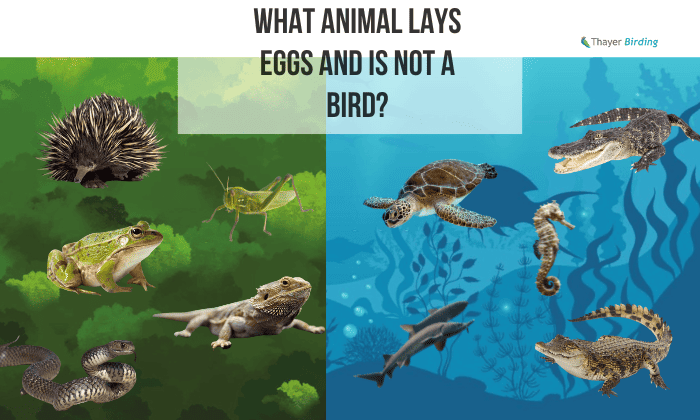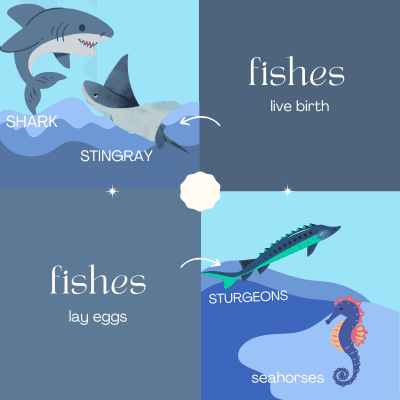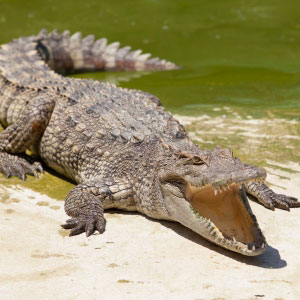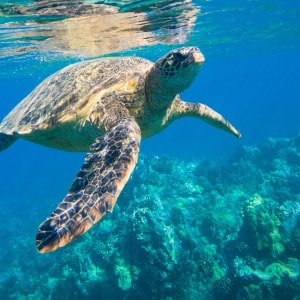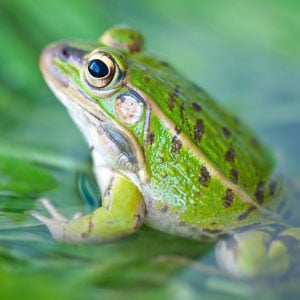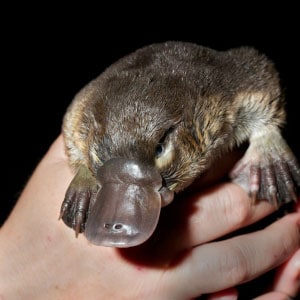Many animals lay eggs besides birds. If you’re looking for animals that lay eggs in water, there are fishes and amphibians. Some even produce eggs with no shells!
For a unique example, there are egg-laying mammals called monotremes, consisting of platypuses and echidnas. Most reptiles, insects, and arthropods are also known egg producers.
Keep reading if you want to discover what animal lays eggs and is not a bird. We’ll also share facts about these fascinating creatures.
Table of Contents
Non-Avian Egg-Laying Animals
These are the different animals that lay eggs (excluding birds):
1. Fish
Our first animal that is not a bird but lays eggs is fish. However, it’s important to clarify that not all fishes lay eggs. Some, such as sharks and rays, produce live young or fry.
Meanwhile, egg-laying fishes release their eggs first to be fertilized externally. There are several types:
- Buriers
- Scatterers
- Depositors
- Nest-builders
- Mouthbrooders
Some interesting species of egg-laying fish are sturgeons and seahorses (despite appearances, the latter are a type of pipefish). Sturgeon eggs are often used to make caviar, a luxury food. Meanwhile, male seahorses receive the female’s eggs and carry them until they’re fully formed.
2. Crocodiles
Crocodiles reproduce by laying eggs in a mound or nest. Interestingly, the incubation temperature affects the biological sex of the offspring.
These are the resulting sexes based on temperature:
| Temperature | Crocodile Hatchling Sex |
| 30°C or less | All females |
| 31°C | Both males and females |
| 32°C – 33°C | Both males and females BUT mostly males |
| 33°C | All males or all females (depends on the species) |
Also, crocodiles are capable of parthenogenesis or reproducing even without a male! At least, that was the case with the isolated American crocodile in Costa Rica, which laid eggs in 2018. Unfortunately, none survived, but there were stillborns.
3. Alligators
Alligators look much like crocodiles, and they lay eggs, too! However, there are critical differences between the two animals. For instance, the usual way to differentiate an alligator from a crocodile is by the shape of the snout: an alligator’s is U-shaped, while a crocodile’s is V-shaped.
In terms of eggs, alligators share many similarities with crocodiles. Firstly, the offsprings’ sexes are also determined by temperature, with cool temperatures resulting in females and warm climates leading to males. Alligator eggs are also noted to be squishy and leather-like, especially as they mature.
4. Turtles (Including Tortoises)
Turtles, including tortoises, are another animal that lays eggs. There are many types of turtles, but they are all noted for laying their eggs on land. Some species, like sea turtles, even travel distances to return and nest on the beaches they hatched in.
Another similarity sea turtles share with co-reptiles, alligators, and crocodiles: temperature influences the offsprings’ sexes. However, the trend is inverse: cooler sand (28°C or below) results in many males, while warmer temperatures (31°C or above) lead to several females.
Intermediate temperatures result in an equal abundance of both males and females.
5. Snakes
Around 70% of snake species lay eggs. The other 30% do not include the common garter snakes, emerald tree boa, common boa, and other species. Giving birth to live young may have been an adaptation to survive cold climates.
Snake eggs are known to have an elliptical or oval shape, are plain white, and feel soft and leathery. Sometimes, they appear off-white or beige but are never spotted or speckled. Also, most snakes abandon their eggs after laying them.
If you chance upon snake eggs, you must be careful around them. Slight disturbances can affect the offspring inside.
6. Lizards
Many lizards are egg layers. There are some exceptions, and they typically live in higher elevations.
However, what’s most notable about lizard reproduction is that some species can BOTH lay eggs and give birth to live young. An example is the three-toed skink, which produces eggs in northern New South Wales, Australia, but live young near Sydney. This is an exciting discovery as most species just do one or the other, very rarely both.
Lizards are also capable of parthenogenesis. One example is the Asian water dragon, whose asexual reproductive abilities were only discovered by zookeepers in 2016.
7. Frogs
Frog eggs lay eggs with no shells. Instead, they may appear as transparent spheres or blobs with a black spot in the center. There are many types:
- Single eggs – a frog egg that is not attached to another
- Egg clusters – multiple eggs that are grouped together
- Surface film of eggs – eggs that are laid on a floating surface film
- Strings of eggs – instead of clusters, eggs can be found strung together like beads
These eggs may be found at the bottom of a pond, attached to a plant, wrapped around vegetation, or floating on a pool of water.
8. Toads
Toads, which look similar to frogs, have eggs that are much like frog eggs. They’re also translucent, lacking shells, and surrounded by a jelly-like substance. They must also always be kept in water and are often spawned in multiples.
However, some traits still distinguish toad eggs from those of frogs. For instance, toads typically lay their eggs in strands, strings, or chains, rather than clusters.
9. Arthropods
Phylum Arthropoda is one of the most diverse animal groups, consisting of creatures with varying appearances and abilities. Still, most are united by this: they lay eggs to reproduce. Indeed, only a select few, like aphids, scorpions, and blowflies, do not.
These eggs can be laid in singles, clusters, or an ootheca, an egg case. Their appearances are also as diverse as the phylum.
Some have egg sacs, little yolk, mosaic patterns, green colors, or lacy patterns. Others, like the zebra-longwing butterfly egg, even have cyanide or toxins within!
10. Platypus
The platypus is a monotreme, the only mammal order that lays eggs. It is also one of the most perplexing animals discovered on Earth.
It has the bill of a duck, the feet and body of an otter, the tail of a beaver, lays eggs like a bird, produces milk like mammals, and has venom. Eventually, it was classified as a mammal and placed into a new order with egg-laying echidnas.
As mentioned, platypuses lay eggs. A platypus egg feels leathery, like those of reptiles. Also, babies have an egg tooth or horny spike they use to get out of it.
11. Echidnas
The other members of the order Monotrema are four species of echidnas, also known as spiny anteaters. They can compete with platypuses as one of the most baffling creatures.
Firstly, their prominent spines are made of hair and can take on different colors, like blonde or red. They also don’t have teeth. Instead, they use their long, sticky tongue to get yummy insects.
As a monotreme, echidnas lay eggs, which are also leathery. However, unlike platypuses, they have a pouch like marsupials! After ten days only, the egg hatches into a baby echidna called a puggle.
Conclusion
What animal lays eggs and is not a bird? There are many – fishes, reptiles, amphibians, arthropods, and monotremes.
But unlike birds, egg laying within these animal groups is inconsistent. For instance, most fishes, reptiles, amphibians, and arthropods lay eggs, but there are exceptions like sharks, some snakes, a few salamanders, and aphids.
The eggs of these animals may also look different from the usual, hard-shelled bird eggs. For instance, many of them have soft, leathery shells. Meanwhile, some don’t have shells at all!

George and I became friends after a birdwatching trip with our new group. And we have been enjoying every adventure together. When he told me the idea of establishing a site that shares our experiences and fun, I immediately agreed. After trials and errors, here we have Thayerbirding.


